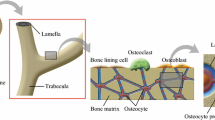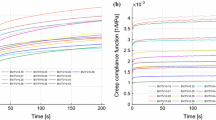Abstract
It is widely accepted that the pressure variation of interstitial fluid is one of the most important factors in bone physiology. In order to understand the role of interstitial fluid on porous bony structure, a consideration for the biomechanical interactions between fluid and solid constituents within bone is required. In this study, a poroelastic theory was applied to investigate the elastic behavior of calf vertebral trabecular bone composed of the porous solid trabeculae and the viscous bone marrow. The poroelastic behavior of trabecular bone in a uniaxial stress condition was simulated using a commercial finite difference analysis software (FLAC, Itasca Consulting Group, USA), and tested for 5 different strain rates, i. e., 0.001, 0.01, 0.1, and 10 per second. The material properties of the calf vertebral trabecular bone were utilized from the previous experimental study. Two asymptotic poroelastic responses, the drained and undrained deformations, were predicted. From the predicted results for the simulated five strain rates, it was found that the pore pressure generation has a linearly increasing behavior when the strain rate is the highest at 10 per second, otherwise it showed a nonlinear behavior. The pore pressure generation with respect to the strain was found to be increased as the strain rate increased. The elastic moduli predicted at each strain were 208.3, 212.2, 337.6, 593.1, and 602.2 MPa, respectively. Based on the results of the present study, it was suggested that the calf vertebral trabecular bone could be modeled as a poroelastic material and its strain rate dependent material behavior could be predicted.
Similar content being viewed by others
References
Arramon, Y. P. and Cowin, S. C., 1994, “Strain Rate as a Bone Remodeling Stimulus,”ASME, BED-28, pp. 259–260.
Bryant, J. D., 1988, “On the Mechanical Function of Marrow in Long Bone,”Proc. Instn. Mech. Engrs., Part H, J. Eng. Med., Vol. 17, pp. 55–58.
Carter, D. R. and Hayes, W. C., 1977, “The Compressive Behavior of Bone as a Two-Phase Porous Structure,”J. Bone Jt. Surg., Vol. 59A, pp. 954–962.
Cowin, S. C., 1999, “Bone Poroelasticity,”J. Biomech., Vol. 32, pp. 217–238.
Detournay, E. and Cheng, H. D., 1993,Fundamentals of Poroelasticity. Comprehensive Rock Engineering: Principles, Practice and Projects (Hudson, J. edited), Vol. 2, pp. 113–171, Pergamon Press.
Ducheyne, P., Heymans, L., Martens, M., Aernoudt, E., de Meester,P. and Mulier, J. C., 1977, “The Mechanical Behavior of Intracondylar Cancellous Bone of the Femur at Different Loading Rates,”J. Biomech., Vol. 10, pp. 747–762.
Green, D. H. and Wang, H. F, 1986, “Fluid Pressure Response to Undrained Compression in Saturated Sedimentary Rock,”Geophys., Vol. 51, pp. 948–956.
Han, S., Medige, J., Faran, K., Feng, Z., and Ziv, I., 1996, “Effect of Loading Rate on the Prediction of Mechanical Properties of Trabecular Bone by Ultrasonic Velocity and Attenuation,”Trans. Orthop. Res. Soc., Vol. 21, p. 82.
Harrigan, T. P. and Hamilton, J. J., 1993, “Bone Strain via Transmembrane Potential Changes in Surface Osteoblasts: Loading Rate and Microstructural Implications,”J. Biomech., Vol. 26, pp. 183–200.
Hong, J. H. and Lim, T. H., 1998, “Poroelastic Model of Trabecular Bone in Uniaxial Strain Condition,” J. Musculoskeletal Res., Vol. 2, pp. 167–180.
Huges, M. S., Davies, R., Khan, R., and Kelly, P., 1978, “Fluid Space in Bone,”Clin. Orthop. Res., Vol. 134, pp. 332–341.
Johnson, M. W., 1984, “Behavior of Fluid in Stressed Bone and Cellular Stimulation,”Calcif. Tissue Int., Vol. 36 (S), pp. 72–76.
Johnson, M. W., Chakkalakal, D. A., Harper, R. A., Karz, J. L., and Rouhana, S. W., 1982, “Fluid Flow in Bone,”J. Biomech., Vol. 11, pp. 881–885.
Keaveny, T. M., Guo, X. E., Wachtel, E. F., McMahon T. A., and Hayes, W. C., 1994, “Trabecular Bone Exhibits Fully Linear Elastic Behavior and Yields at Low Strains,”J. Biomech., Vol. 27, pp. 1127–1136.
Lim, T. H. and Hong, J. H., 2000, “Poroelastic Properties of Bovine Vertebral Trabecular Bone,” J. Orthop. Res., Vol. 18, pp. 671–677.
Linde, F., Nørgaard, P., Hvid, I., Odgaard, A., and Søballe, K., 1991, “Mechanical Properties of Trabecular Bone. Dependence on Strain Rate,”J. Biomech., Vol. 24, pp. 803–809.
Luo, Z. P., Ochoa, J. A., and Hillberry, B. M., 1993, “Effects of Specimen Size on Hydraulic Stiffening of Cancellous Bone,”Trans. Orthop. Res. Soc., Vol. 18, p. 174.
Nowinski, J. L. and Davis, F. C., 1969, “The Flexure and Torsion of Bones as Anisotropic Poroelastic Materials,”In proceeding 7th Ann. Meet. Soc. Eng. Sci.
Nowinski, J. L. and Davis, F. C., 1970, “The Human Skull as a Poroelastic Spherical Shell Subjected to a Quasi-Static Load,”Mathem. Biosci., Vol. 8, pp. 397–416.
Nowinski, J. L., 1971, “Bone Articulartions as Systems of Poroelastic Bodies in Contact,”J. Amer. Inst. Aeron. Astron., Vol. 9, pp. 62–67.
Nowinski, J. L., 1972, “Stress Concentration Around a Cylindrical Cavity in a Bone Treated as a Poroelastic Body,”Acta Mechanica, Vol 13, pp. 281–192.
Rice, J. R. and Cleary, M. P., 1976, “Some Basic Stress-Diffusion Solutions for Fluid Saturated Elastic Porous Media with Compressible Constituents,”Res. Geophys. Space Phys., Vol. 14, pp. 227–241.
Scheidegger, A. E., 1957,The Physics of Flow Through Porous Media, University of Toronto Press.
Schoenfeld, C. M., Lautenschlager, E. P., and Meyer, P. R., 1974, “Mechanical Properties of Human Cancellous Bone in Femoral Head,”Med. Biol. Eng., Vol. 12, pp. 313–317.
Simon, B. R., Wu, J. S. S., Carlton, M. W., Kazarian, L. E., France, E. P., Evans, J. H., and Zienkiewicz, O. C., 1985, “Poroelastic Dynamic Structural Models of Rhesus Spinal Motion Segments,”Spine, Vol. 10, pp. 494–507.
Tateishi, T., 1979, “Rheological Characteristics of Human Joints,”Recent Research on Mechanical Behavior Solids, pp. 179–204, Univ. Tokyo Press, Tokyo, Japan.
Weinbaum, S., Cowin, S. C. and Zeng, Y., 1994, “Excitation of Osteocytes by Mechanical Loading Induced Bone Fluid Shear Stress,”J. Biomech., Vol. 27, pp. 339–360.
Zhang, D. and Cowin, S. C., 1994, “Oscillatory Bending of a Poroelastic Beam,”J. Mech. Phys. Solids, Vol. 42, pp. 1575–1599.
Author information
Authors and Affiliations
Corresponding author
Rights and permissions
About this article
Cite this article
Hong, J.H., Mun, M.S. & Lim, TH. Strain rate dependent poroelastic behavior of bovine vertebral trabecular bone. KSME International Journal 15, 1032–1040 (2001). https://doi.org/10.1007/BF03185281
Issue Date:
DOI: https://doi.org/10.1007/BF03185281




